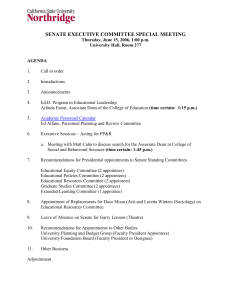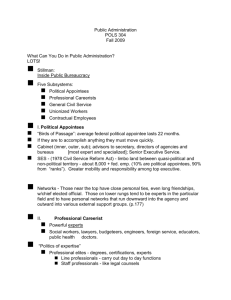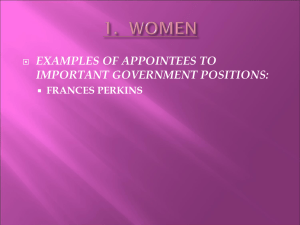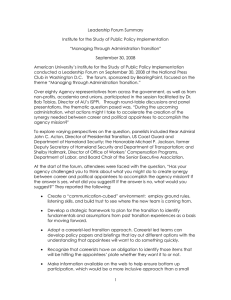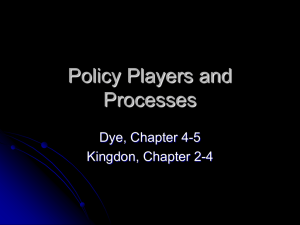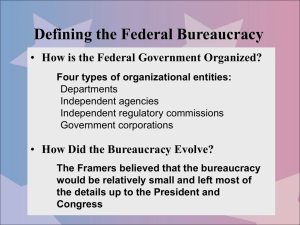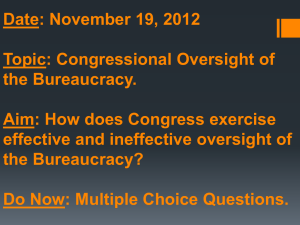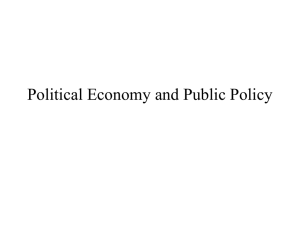Tuesday Lecture
advertisement
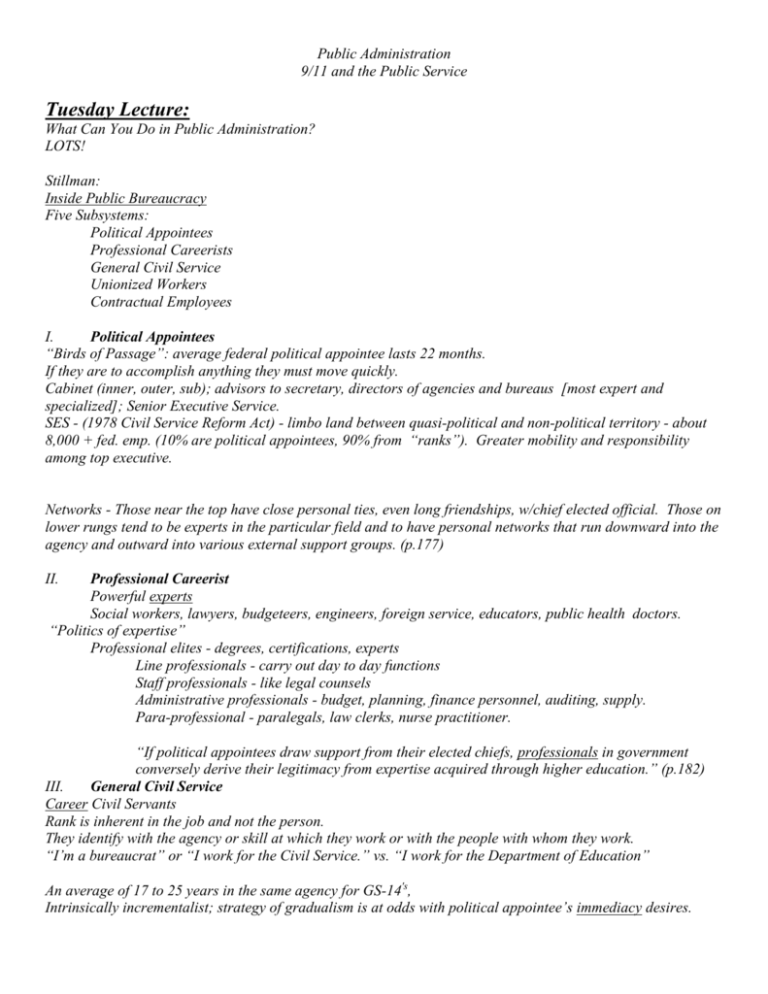
Public Administration 9/11 and the Public Service Tuesday Lecture: What Can You Do in Public Administration? LOTS! Stillman: Inside Public Bureaucracy Five Subsystems: Political Appointees Professional Careerists General Civil Service Unionized Workers Contractual Employees I. Political Appointees “Birds of Passage”: average federal political appointee lasts 22 months. If they are to accomplish anything they must move quickly. Cabinet (inner, outer, sub); advisors to secretary, directors of agencies and bureaus [most expert and specialized]; Senior Executive Service. SES - (1978 Civil Service Reform Act) - limbo land between quasi-political and non-political territory - about 8,000 + fed. emp. (10% are political appointees, 90% from “ranks”). Greater mobility and responsibility among top executive. Networks - Those near the top have close personal ties, even long friendships, w/chief elected official. Those on lower rungs tend to be experts in the particular field and to have personal networks that run downward into the agency and outward into various external support groups. (p.177) II. Professional Careerist Powerful experts Social workers, lawyers, budgeteers, engineers, foreign service, educators, public health doctors. “Politics of expertise” Professional elites - degrees, certifications, experts Line professionals - carry out day to day functions Staff professionals - like legal counsels Administrative professionals - budget, planning, finance personnel, auditing, supply. Para-professional - paralegals, law clerks, nurse practitioner. “If political appointees draw support from their elected chiefs, professionals in government conversely derive their legitimacy from expertise acquired through higher education.” (p.182) III. General Civil Service Career Civil Servants Rank is inherent in the job and not the person. They identify with the agency or skill at which they work or with the people with whom they work. “I’m a bureaucrat” or “I work for the Civil Service.” vs. “I work for the Department of Education” An average of 17 to 25 years in the same agency for GS-14's, Intrinsically incrementalist; strategy of gradualism is at odds with political appointee’s immediacy desires. Remember: The Pendleton Act of 1883 “Whether because of the pejorative connotations attached to government work or the more personal attachment to a particular assigned task, most bureaucrats lack common ties with government as a whole or with the broad public orientation of their work.” (p.184) IV. Unionized Workers 1912 - Lloyd La Follet Act: right of Fed. Workers to unionize. (p.187) 1962 - John Kennedy signed Executive Orders giving unions the right to bargain collectively with federal management on a limited range of items. AFSCME - American Federation of State, County and Municipal Employees. Unions About 35% of government workers are unionized (90% of postal workers) Education, transportation, refuse collection have a higher level of union activity. Bargaining is difficult because of the fractured (80,000+ jurisdictions) nature of government as the “management’ side of a negotiation. Also - wages and hours are generally legislated, and beyond the scope of negotiations. “Blue flu” or “sick outs”. How do you organize a union if you can’t strike? (13 states allow it. Not the Federal Government; not most states). Union values often at odds with civil service values of open, competitive exams, individual competence, etc. V. Contract Employment 16% of total annual operating budget for Fed. Gov’t. is “other contractual services” (p.191) 14% is for internal personnel and benefits (not including pensions) Common examples: Weapons systems, NASA, Capitol Projects, grants for research and development. Contracting Out New PA skills needed: contract negotiation, formal agreements, legal sanctions, economic rewards and penalties for inducing contractor compliance, auditing and contract management. “If their personnel were counted as government employees, the size of the government bureaucracy would probably be twice as large as it is.” (p.192) Contracting Games Contracting out allows claims of “Keeping the lid on government personnel costs while still providing services for constituents.” (p.192) Problems: Imposing government values of responsiveness, accountability, equity, accessibility etc. on private contract workers. “Captives” to the contractor. Catastrophe and Public Service: Government Response to the Destruction of the World Trade Center ______ to summarize What are the facts of the case? Give examples of: “Cool” government workers Professionally trained administrators Specific jobs (or not so much!) Bureaucracy Politics/Admin. Dichotomy Everyone: Can you apply some of what we just discussed? Political Appointees Professional Careerists General Civil Service Unionized Workers Contractual Employees Thusday Lecture: 9/11 Unbuilding… Memorable Instrumental Hands Memri: 2009 Message from Osama Bin Laden Friday Sermon in the Sudan Egyptian Pol. Sci. Professor and former MP Unbuilding the World Trade Center Stillman, Page 166 ___________________ to summarize. Who are the characters? What is the setting (context). What are the facts of the case? Give examples of: Progressivism Politics/Admin Dichotomy Bureaucracy Can we compare the cases? Is America a “dictatorship of rationalists”? What do we fear more than the loss of efficiency? Question Time Fresh Kills, Fish Kills, Arthur Kills… Why such death and mayhem? Actually, it’s Dutch! For creek or riverbed - kille Learn something new everyday!
